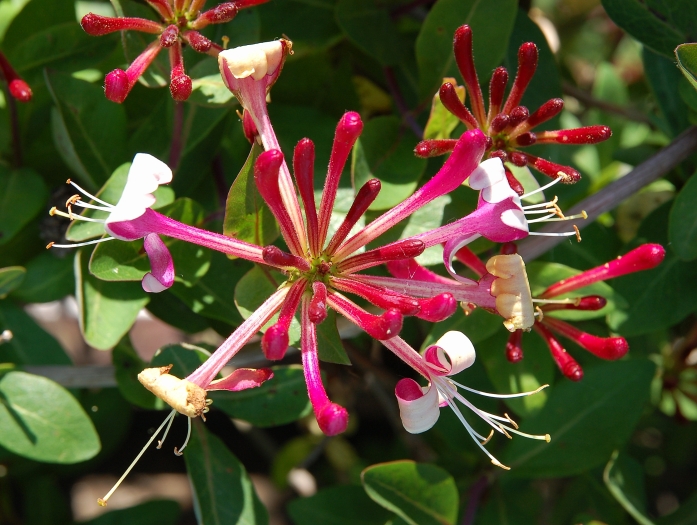European Honeysuckle
(Lonicera periclymenum)
European Honeysuckle (Lonicera periclymenum)
/
/

Luc Viatour
CC BY-SA 3.0
Image By:
Luc Viatour
Recorded By:
Copyright:
CC BY-SA 3.0
Copyright Notice:
Photo by: Luc Viatour | License Type: CC BY-SA 3.0 | License URL: http://creativecommons.org/licenses/by-sa/3.0/ | Uploader: Lviatour | Publisher: Wikimedia Commons | Title: Lonicera_periclymenum_Luc_Viatour.JPG | Notes: Uploaded own work with UploadWizard |
















































































Estimated Native Range
Summary
Lonicera periclymenum, commonly known as European Honeysuckle, is a deciduous perennial vine native to a variety of habitats including woodlands, hedgerows, and scrublands across Europe. It can grow vigorously to heights of 7 m (23 ft) or more, twining around structures and other plants. The plant features tubular, two-lipped flowers that are creamy white or yellowish, often flushed with pink or red on the outside and in bud. These flowers are borne in showy clusters at the ends of the shoots and emit a strong, sweet fragrance at night, which is less pronounced during the day. European Honeysuckle blooms in the summer and is valued for its ornamental qualities, including its ability to cover walls or fences and the intense fragrance of its flowers.
In cultivation, European Honeysuckle is appreciated for its ease of maintenance and the ability to attract pollinators like bees and butterflies. It is often used to cover unsightly structures or as a companion plant that can twine around arbors or trellises. The plant prefers its roots in cool, shaded areas while the flowering tops thrive in sun or light shade. It adapts to a range of soil types, provided they have good drainage, and requires medium amounts of water. Popular cultivars include ’Graham Thomas’ and ’Serotina’, both of which have received the Royal Horticultural Society’s Award of Garden Merit. However, gardeners should be aware that it can grow large and may require pruning to manage its size. Potential problems include aphid infestations and powdery mildew.CC BY-SA 4.0
In cultivation, European Honeysuckle is appreciated for its ease of maintenance and the ability to attract pollinators like bees and butterflies. It is often used to cover unsightly structures or as a companion plant that can twine around arbors or trellises. The plant prefers its roots in cool, shaded areas while the flowering tops thrive in sun or light shade. It adapts to a range of soil types, provided they have good drainage, and requires medium amounts of water. Popular cultivars include ’Graham Thomas’ and ’Serotina’, both of which have received the Royal Horticultural Society’s Award of Garden Merit. However, gardeners should be aware that it can grow large and may require pruning to manage its size. Potential problems include aphid infestations and powdery mildew.CC BY-SA 4.0
Plant Description
- Plant Type: Vine
- Height: 10-20 feet
- Width: 3-6 feet
- Growth Rate: Moderate
- Flower Color: Cream, Pink, Yellow
- Flowering Season: Summer
- Leaf Retention: Deciduous
Growth Requirements
- Sun: Full Sun, Part Shade
- Water: Medium
- Drainage: Slow, Medium, Fast
Common Uses
Bank Stabilization, Bee Garden, Bird Garden, Border Plant, Butterfly Garden, Fragrant, Hummingbird Garden, Potted Plant, Showy Flowers
Natural Habitat
Woodlands, hedgerows, and scrublands across Europe
Other Names
Common Names: Woodbine Honeysuckle, Almindelig Gedeblad, Wald-Geißblatt, Ruotsinköynnöskuusama, Chèvrefeuille Des Bois, Vivendel, Wilde Kamperfoelie, Vildkaprifol
Scientific Names: , Lonicera periclymenum, Lonicera serotina, Lonicera periclymenum var. quercifolia, Lonicera periclymenum var. serotina, Lonicera periclymenum var. quercina, Lonicera periclymenum f. quercina, Lonicera periclymenum var. belgica, Caprifolium vulgare, Lonicera belgica
GBIF Accepted Name: Lonicera periclymenum L.